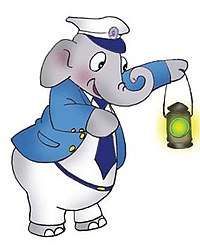Bholu (mascot)
Bholu (The Elephant) [Train Guard/TG (In-Charge of Train)] is the mascot of Indian Railways. The mascot — a cartoon of an elephant holding a signal lamp with a green light in one hand- was initially designed for Indian Railways' 150th year commemoration events and was unveiled on 16 April 2002 in Bangalore. Later in 2003, Indian Railways decided to permanently retain it as the official mascot.[1] The icon was placed on the reverse of a coin.[2]
| Bholu (The Elephant) [Train Guard (In-Charge of Train)] | |
|---|---|
 | |
| Created by | National Institute of Design |
| Role | Mascot of Indian Railways |
| Unveiled on | 16 April 2002 |
| In-universe information | |
| Species | Elephant |
Development
Railways were introduced in India on 16 April 1853, with a line from Bombay to Thane. To commemorate the 150th year of the event, Indian Railways planned a series of events in 2002–03 which included launching a mascot. Bholu was designed by the National Institute of Design in consultation with the Railway ministry[3] and was unveiled on 16 April 2002 in Bangalore. On that day, Bholu flagged off the Karnataka Express at 6.25 pm from platform number 1 of the Bangalore city station.[1] According to the Indian Government (Railway Board)'s Manual for Public Relations Department (2007), Bholu was designated for official use effective 15 April 2002. Later, on 24 March 2003, they decided to retain Bholu as the official mascot of Indian Railways.[4]
Qualification, Designation & Work
The educational qualification of the Train Guard/TG is Graduation (10+2+3) in any discipline. It is the one & only post in Indian Railways which was reserved for the Britishers in the British era, at that time one & only the graduate Britishers were recruited for this post. He is the In-Charge of Train (Coaches or Wagons with Loco) and this post is a Supervisory (Non-Gazetted Officer) post in Traffic (Operating) department of Indian Railways. They have only two designations, the first one is Train Guard/TG and the last one is Senior Train Guard/Sr TG, but their authorizations are different, the first one is for Freight (Goods & Parcel) trains, the last one is for Coaching (Passenger & Mail Express) trains. At first he checks the Mechanical V certificate/M V (Brake Power Certificate/BPC) of the Senior Section Engineer/SSE of Coaching & Depot/C & D department or Carriage & Wagon/C & W department of his working station, if there is any dispute in this paper, he should give a memo to the Deputy Traffic Controller/Dy TC of his working division through the Deputy Station Master/Dy SM of his working station, after this he takes the Caution Order (Sectional Speed Restriction order) of the Divisional Engineer/DE of Civil Engineering department of his working division through the Deputy Station Master/Dy SM of his working station, after these he takes over the charge of the train and he goes to the Train Guard cab of his train, then he checks the Air Pressure Continuity/APC from the Train Guard Cab to the Loco with the Loco Driver/LD by dropping the air pressure, if everything is ok, he should give the Deputy Traffic Controller/Dy TC ready through the Deputy Station Master/Dy SM, then the Deputy Traffic Controller/Dy TC gives the Deputy Station Master/Dy SM permission to change the aspect of signal from on (red) to off (green), then the Deputy Station Master/Dy SM changes the aspect of signal from on to off, at this time Loco Driver/LD observes the off signal, then the Loco Driver/LD takes the permission from him to start the train through the Assistant Loco Driver/ALD, then he gives the Loco Driver/LD permission to start the train through Assistant Loco Driver/ALD and the Loco Driver/LD always follows his command through Assistant Loco Driver/ALD, he holds a multicolour flashlight with green light in one hand to exchange All Right Signal/ARS with the Deputy Station Master/Dy SM and Assistant Loco Driver/ALD. The Train Guard/TG is the initial person in Indian Railways who has the authority to control the movement of a train, then the Traffic Controllers/TCs, the Operating Managers/OMs. [4] The green light is the symbol of movement, which assures trains and passengers to go ahead with safety and without fear.[5]
Popularity
The mascot became very popular in India. When asked why they chose an elephant as their mascot and of their opinion on Bholu, Indian Railway officials said that Bholu is friendly and helpful.[1] An Indian Government official release in 2003 described Bholu as an "ethical, responsible, sincere and cheerful icon". The same report stated that other than denoting stability, it represents the Indian Railways workforce as well.[5] Also in 2003 the Indian Government released a two-(₹) rupee coin which carried the impression of Bholu on its reverse side.[2]
References
- "Bholu the Railways mascot unveiled". The Times of India. 16 April 2002. Retrieved 11 May 2013.
- "Commemorative currency". Indian Government. 1 September 2003. Retrieved 11 May 2013.
- "Coins to mark 150 years of Railways". Tribune India. 13 July 2003. Retrieved 11 May 2013.
- "Manual for Public Relations Department (2007)" (PDF). Government of India, Ministry of Railways (Railway Board). pp. 30–31. Retrieved 11 May 2013.
- "Bholu to stay with Railways". The Hindu. 24 April 2003. Retrieved 11 May 2013.
External links
- Kunnappally, Joseph. "2 Rupees 150 Years of Indian Railways". Retrieved 11 May 2013.